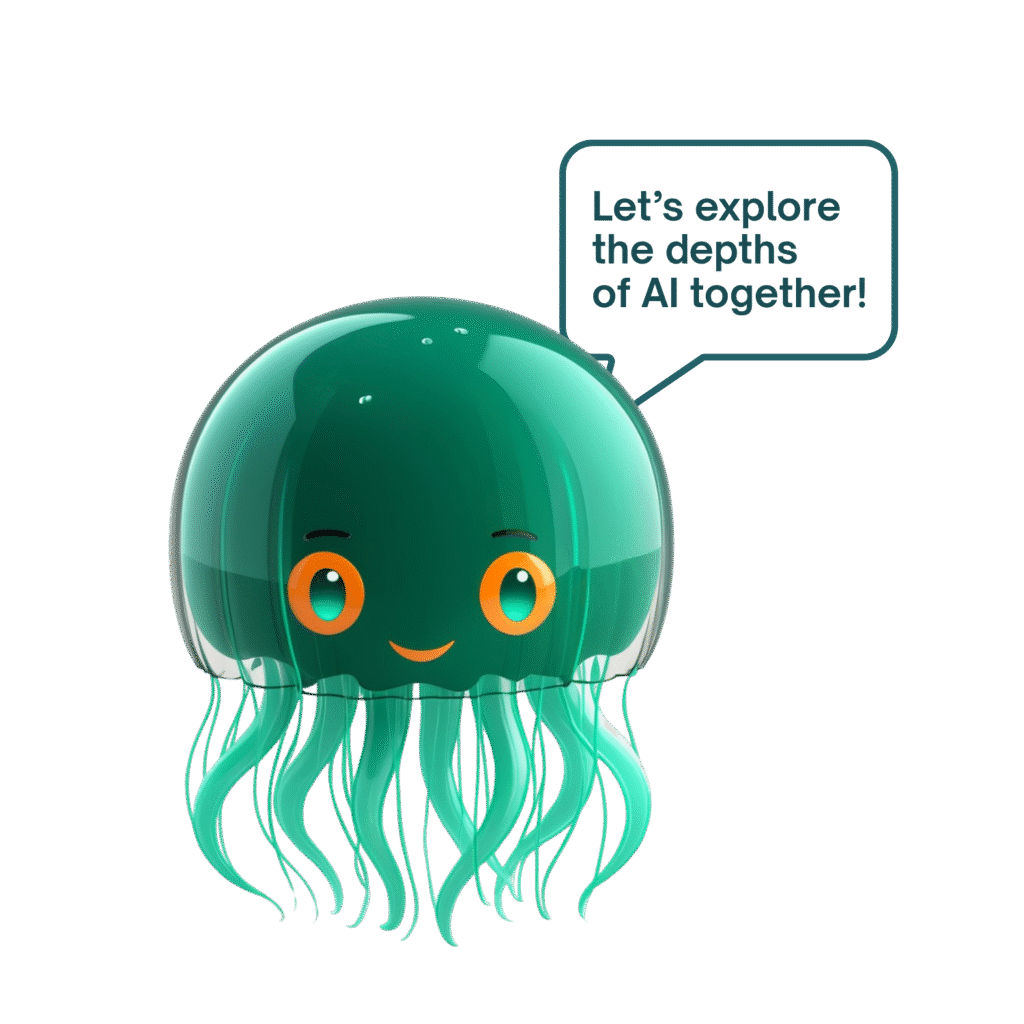Starting with AI implementation can feel like navigating uncharted waters — it’s exciting, but it can also be a bit overwhelming.
Many organizations are unsure about how to start with AI implementation, and that’s completely normal. But here’s the thing: with the right guidance, you don’t have to navigate it alone.
🪼 I’m Maj, the AI-generated jellyfish, and I’ll help you find your way through this journey. Together, we’ll explore how to start with AI implementation and ensure you’re on the right track for success.
➡️ If you’re interested in learning more about Maj the Jellyfish and the AI Ocean, read the article ‘What Can a Jellyfish Teach You About Artificial Intelligence? Meet Maj!’

Let’s explore the depths of AI together!
FAQ 1: What are the first steps in how to start with AI implementation?
➡️ Getting started with AI implementation doesn’t have to be overwhelming.
Here’s what you need to consider first:
✅ Measure results: Define clear success metrics from the beginning so you can track AI’s impact and optimize.
✅ Set clear objectives: Understand what you want to achieve with AI. Is it automation, efficiency, or better decision-making?
✅ Assess your data: Do you have the necessary data, and is it of high quality? AI needs good data to function effectively.
✅ Start small: Implement AI in manageable, low-risk projects first. Test the waters before going all in.
Still unsure where to begin with AI implementation? Let’s talk. 📩
💡 Book consultation and uncover what’s worth exploring — and what’s not – click here!
FAQ 2: What kind of problems can AI actually help solve?
🔎 It’s a common question — and a critical one. Many organizations explore AI with curiosity, but hesitate because they’re not sure whether their challenges are even “AI-worthy”.
💬 Some of the real questions decision-makers ask before AI implementation:
- “Can AI solve anything we’re actually struggling with?”
- “Do we need huge datasets to even begin?”
- “Is it just for chatbots and customer service?”
- “Where would AI make the biggest difference — and where would it be overkill?”
🧠 The truth is: Generative AI and AI Automation can support a wide range of operational, strategic, and creative challenges — but they’re not universal solutions for every pain point.
Here are examples of areas where AI often delivers tangible value:
- Automating repetitive knowledge work — like document generation, reporting, content tagging.
- Summarizing and organizing information from meetings, transcripts, or internal knowledge bases.
- Enhancing decision-making with pattern detection or scenario analysis.
- Supporting creative teams in brainstorming or producing high-volume content drafts.
- Personalizing user experiences at scale — from emails to product suggestions.
➡️ But before jumping into tools, it’s essential to define:
- What specific friction or inefficiency you want to address.
- Whether AI is the best method — or if a simpler process fix would work better.
- How success will be measured.
➡️ Many organizations fail not because AI “didn’t work,” but because they chose it without clearly identifying the problem first.
FAQ 3: How do we know if our organization is ready to start with AI implementation?
Knowing how to start with AI implementation doesn’t begin with tools — it begins with readiness.
This means understanding whether the organization has the mindset, structures, and foundations in place to make AI work for you — not against you.
🔎 Here’s how to recognize early signs of readiness:
- ✅ Clear objectives for AI use.
Not just a trend, but a well-defined purpose for how AI can address a specific challenge or improve a process. - ✅ Accessible and trustworthy data.
AI relies on data. If the data is fragmented, outdated, or unstructured, it will hinder successful implementation. - ✅ Alignment among key stakeholders.
AI implementation affects multiple departments. If there’s no alignment between leadership, IT, and operations, the process may face significant roadblocks. - ✅ Willingness to experiment and adapt.
AI implementation requires testing and iterations. Rigid systems or inflexible structures can limit the ability to adapt to new tools and methods.
📌 IMPORTANT – not being fully ready isn’t a blocker — it’s a signal to slow down, reflect, and prepare. Identifying gaps is already a step toward success.
➡️ Curious about what “AI implementation” means? Read the full article here!
FAQ 4: What are the key factors to consider when selecting AI tools?
The right tool doesn’t only solve a problem but integrates seamlessly into existing workflows, enabling long-term success.
✅ Scalability.
As your needs grow, the AI tool should grow with you. It’s essential that the solution can scale and adapt to new requirements over time.
✅ Integration potential.
The AI tool should integrate easily with existing systems (e.g., CRM, ERP, etc.) to avoid costly and complex overhauls.
✅ User-friendliness.
No matter how advanced the AI solution, its usability for non-technical team members is critical. A solution that requires constant technical support can become a burden.
✅ Vendor support and ecosystem.
Look for a provider that offers ongoing support, updates, and a strong community of users. This can make a huge difference when troubleshooting or when scaling the solution.
✅ Data security and privacy.
Ensure that the AI tool complies with relevant data protection regulations (e.g., GDPR). Securing sensitive data should be a top priority.
📌 IMPORTANT – Choosing the right AI tool is one thing, but tailoring it to your organization’s needs is a whole different challenge.
It takes time and effort to properly test and adjust the tool to ensure it’s the right fit. Even after selecting the best solution, you’ll need to assess its performance, make adjustments, and iterate to guarantee that it delivers value in the long run.
FAQ 5: What are the common challenges organizations face when implementing AI?
🏔️ AI implementation is exciting, but it’s not without its challenges.
Organizations often encounter roadblocks during the process. Being aware of common challenges can help you navigate the AI landscape with a clearer understanding and avoid potential pitfalls.
Here are some of the key challenges organizations face:
- 🔴 Lack of clear goals and strategy.
Without a clear roadmap, organizations often struggle to define how AI will add value. Starting without clear objectives can lead to misaligned solutions, wasting both time and resources. - 🔴 Data quality and accessibility.
AI systems rely heavily on quality data. Many organizations face challenges in obtaining clean, structured, and accessible data. Data silos, inconsistent formats, and missing information can slow down AI projects significantly. - 🔴 Resistance to change.
AI implementation often disrupts existing workflows, which can cause resistance from employees. Overcoming this resistance requires thoughtful change management, proper training, and ensuring that teams understand how AI will enhance their work rather than replace it. - 🔴 Skill gaps and talent shortages.
AI requires specialized expertise that may not be readily available within your organization. Finding the right talent or upskilling your team can be a challenge, and lack of skilled professionals can delay or derail AI efforts. - 🔴 Integration with existing systems.
Integrating AI with existing tools and infrastructure is often more complex than anticipated. Organizations often face difficulties in making AI work seamlessly with legacy systems or in aligning AI with other technological tools. - 🔴 Budget constraints.
Implementing AI solutions can be costly, especially for small and medium-sized organizations. Budget limitations can restrict the scope of AI initiatives, which may lead to incomplete or suboptimal implementations.
📌 IMPORTANT – Resistance to change can be a big hurdle in AI adoption. But it’s not just about the tools — it’s about getting your team on board. At Maj Ai, we don’t just offer consulting; we also provide AI training to help your team embrace the change and confidently implement AI.
❇️ Looking to overcome resistance and build AI readiness? Let’s work together to train your team and ensure a smooth AI integration. Click here!


